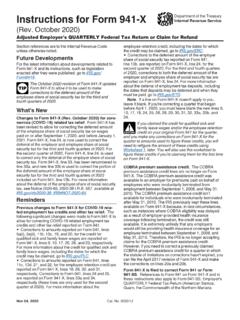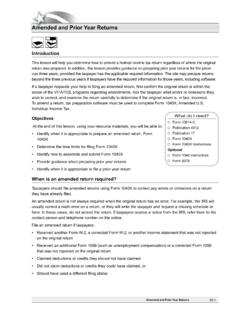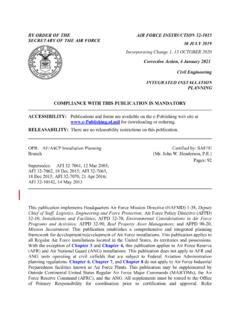Transcription of 1 2 3 4 Determine Implement Root Corrective Causes Actions
1 1 Preserve/ Document Scene2 Collect Information3 Determine Root Causes4 Implement Corrective ActionsUnited States Department of Labor Occupational Safety and Health Administration December 2015 i TABLE OF CONTENTS PURPOSE OF THE GUIDE WHY INVESTIGATE? .. 1 PRINCIPLES OF INCIDENT INVESTIGATIONS .. 1 The Language of Incident Investigations .. 1 Investigate All Incidents, Including Close Calls .. 2 Investigate Programs, Not Behaviors .. 3 Focus on the Root Causes , Not Blame or Fault .. 4 ESTABLISH AN INCIDENT INVESTIGATION PROGRAM .. 4 CONDUCT INCIDENT INVESTIGATIONS A FOUR STEP SYSTEMS APPROACH .. 6 Step 1. Preserve/Document the Scene .. 7 Step 2. COLLECT INFORMATION .. 8 Step 3. Determine ROOT Causes .. 9 Step 4. Implement Corrective Actions .
2 10 RESOURCES .. 12 REFERENCES .. 14 APPENDIX A: INCIDENT INVESTIGATION form .. A 1 APPENDIX B: INCIDENT INVESTIGATOR S KIT .. B 1 APPENDIX C: TIPS FOR VIDEO/PHOTO DOCUMENTATION .. C 1 APPENDIX D: SKETCH THE SCENE TECHNIQUES .. D 1 APPENDIX E: COLLECT INFORMATION CHECKLIST .. E 1 APPENDIX F: SAMPLE QUESTIONS FOR IDENTIFYING INCIDENT ROOT Causes .. F 1 DISCLAIMER: This guide was developed by OSHA's Directorate of Training and Education and is intended to assist employers, workers, and others as they strive to improve workplace health and safety. This guide is advisory in nature and informational in content. It is not a new standard or regulation and does not create any new legal obligations or alter existing obligations created by OSHA standards or regulations or the Occupational Safety and Health Act of 1970 (OSH Act).
3 Pursuant to the OSH Act, employers must comply with safety and health standards and regulations issued and enforced either by OSHA or by an OSHA approved state plan. In addition, the OSH Act s General Duty Clause, Section 5(a)(1), requires employers to provide their workers with a workplace free from recognized hazards likely to cause death or serious physical harm. Implementation of an incident investigation program in accordance with this guide can aid employers in their efforts to provide a safe workplace. Incident [Accident] Investigations: A Guide for Employers December 2015 1 WHY INVESTIGATE? Incident investigations help employers: Prevent injuries and illnesses Save lives Save money Demonstrate commitment to health and safety Promote positive workplace morale Improve management Your company experienced an incident that resulted (or almost resulted) in a worker injury or what?
4 As a responsible employer, you need to react quickly to the incident with a prescribed investigation procedure for finding the root Causes and implementing Corrective Actions . Quick and planned Actions demonstrate your company s commitment to the safety and health of your workers, and your willingness to improve your safety and health management program to prevent future incidents. PURPOSE OF THE GUIDE WHY INVESTIGATE? The purpose of this Incident Investigation Guide is to provide employers a systems approach to help them identify and control the underlying or root Causes of all incidents in order to prevent their recurrence. The Bureau of Labor Statistics reports that more than a dozen workers died every day in American workplaces in 2013, and nearly 4 million Americans suffered a serious workplace injury.
5 And tens of thousands are sickened or die from diseases resulting from their chronic exposures to toxic substances or stressful workplace conditions. These events cause much suffering and great financial loss to workers and their families, and also result in significant costs to employers and to society as a whole. Many more near misses or close calls also happen; these are incidents that could have caused serious injury or illness but did not, often by sheer luck. Practically all of these harmful incidents and close calls are preventable. All incidents regardless of size or impact need to be investigated. The process helps employers look beyond what happened to discover why it happened. This allows employers to identify and correct shortcomings in their safety and health management programs.
6 OSHA created this Guide to help employers conduct workplace incident investigations using a four step systems approach. This process is supported by an Incident Investigation form , found in Appendix A, which employers can use to be sure all details of the incident investigation are covered. Additional tools to assist with the investigation process are found in Appendices B through F. PRINCIPLES OF INCIDENT INVESTIGATIONS The Language of Incident Investigations Employers will notice this Guide uses the term incident , not accident , to describe a workplace event. This is because the word accident has come to be considered as a random event that oh, well, it just Incident Investigations: A Guide for Employers December 2015 2 happened and could not have been prevented.
7 However, the vast majority of harmful workplace events do not just happen. On the contrary, most harmful workplace incidents are wholly preventable. In short, the basic principle is that incidents do not have to occur; they can be prevented by addressing the shortcomings in the programs that manage health and safety in the workplace. The following are the key terms that are used throughout this guide: Incident: A work related event in which an injury or ill health (regardless of severity) or fatality occurred, or could have occurred. Root Causes : The underlying reasons why unsafe conditions exist or if a procedure or safety rule was not followed in a workplace. Root Causes generally reflect management, design, planning, organizational or operational failings ( , a damaged guard had not been repaired; failure to use the guard was routinely overlooked by supervisors to ensure the speed of production).
8 Close Call: An incident that could have caused serious injury or illness but did not; also called a near miss. Investigating a worksite incident a fatality, injury, illness, or close call provides employers and workers the opportunity to identify hazards in their operations and shortcomings in their safety and health programs. Most importantly, it enables employers and workers to identify and Implement the Corrective Actions necessary to prevent future incidents. Incident investigations that focus on identifying and correcting root Causes , not on finding fault or blame, also improve workplace morale and increase productivity, by demonstrating an employer s commitment to a safe and healthful workplace. Investigate All Incidents, Including Close Calls OSHA strongly encourages employers to investigate all workplace incidents both those that cause harm and the close calls that could have caused harm under slightly different circumstances.
9 Investigations are incident prevention tools and should be an integral part of an occupational safety and health management program in a workplace. Such a program is a structured way to identify and control the hazards in a workplace, and should emphasize continual improvement in health and safety performance. When done correctly, an effective incident investigation uncovers the root Causes of the incident or close call that were the underlying factors. Most important, investigations can prevent future incidents if appropriate Actions are taken to correct the root Causes discovered by the investigation. Effective incident investigations are the right thing to do, not only because they help employers prevent future incidents, but because they help employers to identify hazards in their workplaces and shortcomings in their safety and health management programs.
10 Investigations also save employers money, because incidents are far more costly than most people realize. The National Safety Council estimates that, on the average, preventing a workplace injury can save $39,000, and preventing a fatality more than $ million, not to mention the suffering of the workers and their families. The more obvious financial costs are those related to workers' compensation claims, but these are only the direct Incident Investigations: A Guide for Employers December 2015 3 One central the need to consider the organizational factors that create the preconditions for errors as well as the immediate Causes . Sidney Dekker (2006) costs of incidents. The indirect costs are less obvious, but very commonly greater, and include lost production, schedule delays, increased administrative time (for emergency response, investigations, claim processing and others), lower morale, training of new or temporary personnel, increased absenteeism, and damaged customer relations and corporate reputation.















